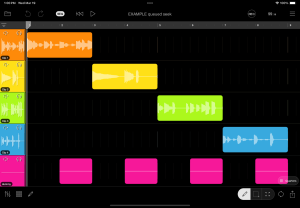Templates:Sequencer Hacks: Difference between revisions
No edit summary Tags: Manual revert Visual edit: Switched |
No edit summary |
||
| Line 5: | Line 5: | ||
== Queue Next == | == Queue Next == | ||
This project template demonstrates one method of queuing a timeline section to play after the currently playing section. You can use MIDI bindings to change up the order of your song on the fly. Want to go back to the bridge or jump to the end | This project template demonstrates one method of queuing a timeline section to play after the currently playing section. You can use MIDI bindings to change up the order of your song on the fly. Want to go back to the bridge or jump to the end? We got you covered. | ||
[[File:Sequence with Dummy Clips.png|alt=Queue Next project sequence view|none|thumb]] | |||
==== How It Works ==== | |||
This project uses a [[Dummy Clip|dummy clip]] with Stop Clip follow action that can jump to a new timeline location. A stepped dial is used to set where the timeline jumps to via the Seek Timeline action. You can use MIDI bindings to set the jump location. After each jump the dial resets itself to do nothing. You can select the jump location (usually via MIDI) any time during a section, and it will be trigger at end of any of the magenta dummy clips added to the timeline. | |||
Download: [[Media:EXAMPLE queued seek.zip|EXAMPLE: queued seek.zip]] | Download: [[Media:EXAMPLE queued seek.zip|EXAMPLE: queued seek.zip]] | ||
{| class="wikitable" | |||
<youtube>OMFLVpC0AoQ</youtube> | |<youtube>OMFLVpC0AoQ</youtube> | ||
|} | |||
Latest revision as of 06:36, 20 March 2025
This article covers some techniques for using Loopy Pro's timeline/sequencer in non-typical ways.
Queue Next
This project template demonstrates one method of queuing a timeline section to play after the currently playing section. You can use MIDI bindings to change up the order of your song on the fly. Want to go back to the bridge or jump to the end? We got you covered.

How It Works
This project uses a dummy clip with Stop Clip follow action that can jump to a new timeline location. A stepped dial is used to set where the timeline jumps to via the Seek Timeline action. You can use MIDI bindings to set the jump location. After each jump the dial resets itself to do nothing. You can select the jump location (usually via MIDI) any time during a section, and it will be trigger at end of any of the magenta dummy clips added to the timeline.
Download: EXAMPLE: queued seek.zip